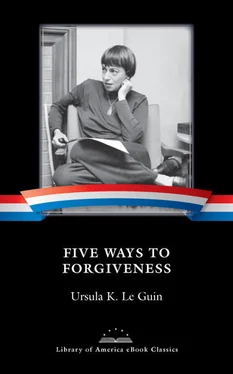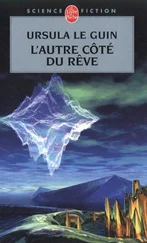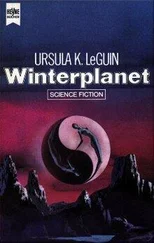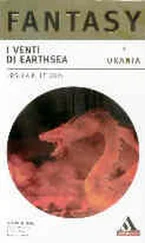The Arkamye or Life of Kamye the Swordsman (Kamye is also the Herdsman, a beastmaster deity, and the Bondsman, having been long in service to Lord Nightfall): a warrior epic, adopted about 3,000 years ago by the assets, pretty much worldwide, as the sourcebook of their own religion. It cultivates such warrior/slave virtues as obedience, courage, patience, and selflessness, as well as spiritual independence, a stoical indifference to the things of this world, and a passionate mysticism: reality is to be won only by letting the seeming-real go. Assets and veots include Tual in their worship as an incarnation of Kamye, himself an incarnation of Ama the Increate. The “stages of life” and “going into silence” are among the mystical ideas and practices shared by Kamyites and Tualites.
Relations with the Ekumen
The First Envoy (EY 1724) was met with extreme suspicion. After a closely guarded deputation was allowed to land from the ship Hugum , alliance was rejected. Aliens were forbidden to enter the solar system by the Government of Voe Deo and its allies. Werel, led by Voe Deo, then entered on a rapid, competitive development of space technology and intensification of all techno-industrial development. For many decades, Voe Dean government, industry, and military were driven by a paranoid expectation of the armed return of conquering Aliens. It was this development that led within only thirteen years to the colonisation of Yeowe.
During the next three centuries the Ekumen made contact at intervals with Werel. An exchange of information was initiated at the insistence of the University of Bambur, joined by a consortium of universities and research institutions. Finally, after over three hundred years, the Ekumen was permitted to send a few Observers. During the War of Liberation on Yeowe, the Ekumen was invited to send Ambassadors to Voe Deo and Bambur, and later Envoys to Gatay, the Forty States, and other nations. For some time nonobservance of the Arms Convention kept Werel from joining the Ekumen, despite pressure from Voe Deo on the other states, which insisted on retaining their weaponry. After the abrogation of the Arms Convention, Werel joined the Ekumen, 359 years after first contact and 14 years after the end of the War of Liberation.
As a property of the Corporations, having no government of its own, Yeowe Colony was considered by its Werelian owners to be ineligible for Ekumenical membership. The Ekumen continued to question the right of the Four Corporations to ownership of the planet and its people. During the last years of the War of Liberation, the Freedom Party invited Ekumenical observers to Yeowe, and the establishment of a regular Envoy there coincided with the end of the War. The Ekumen helped Yeowe negotiate an end to the economic control of the planet by the Corporations and the Government of Voe Deo. The World Party nearly succeeded in driving the Aliens as well as the Werelians off the planet, but when that movement collapsed, the Ekumen supported the Provisional Government until elections could be held. Yeowe joined the Ekumen in Year of Liberation 11, three years before Werel did.
YEOWE
Natural History
The third planet out from its sun, Yeowe has a warm-moderate climate with little seasonal variation.
Bacterial life is ancient and of normally vast complexity and adaptive variety. A number of microscopic marine Yeowan species are defined as animals; otherwise, the native biota of the planet were plants.
On land there was a great variety of complex species, photosynthetic or saprophytic. Most were sessile, with some “creepers,” colonial or individual plants capable of slow movement. Trees were the principal large life-form. South Continent was almost entirely tropical jungle/temperate rain forest from the coastlines up to timberline in the Polar Range and to the taiga of the Antarctic Circle. Great Continent, forested in the extreme north and south, was a steppe and savannah landscape at the higher central altitudes, with immense areas of bog, marsh, and sea marsh on the coastal plains. In the absence of pollinating animals, the plants had many devices to use wind and rain to cross-fertilise and propagate: explosive seeds, winged seeds, seednets that catch the wind and float for hundreds of miles, waterproof spores, “burrowing” seeds, “swimming” seeds, and plants with mobile vanes, cilia, etc.
The seas, which are warm and relatively shallow, and the vast sea marshes nourish a huge variety of sessile and floating plants, on the order of plankton, algaes, seaweeds, coral-type and sponge-type plants forming permanent constructions (mostly of silicon), and unique plants such as the “sailers” and the “mirrorweed.” Vast connected “lily mats” were harvested by the Corporations so efficiently as to render the species extinct within thirty years.
Heedless introduction of Werelian plant and animal species killed off or crowded out about 3/5 of the native species, aided by industrial pollution and war. The owners brought in deer, hunting dogs, hunting cats, and greathorses for their hunts. The deer thrived and destroyed a great deal of native habitat. Most introduced animal species failed in the long run. Werelian animal survivors other than humankind on Yeowe include:
birds (domestic fowl brought in as game or as poultry; songbirds were released, and a few species adapted and survived)
foxdogs and spotted cats (pets)
cattle (domestic; many wild in abandoned districts)
deer (wild, called fendeer, adapted to the marsh regions)
hunting cats (feral, rare, in marshlands)
The introduction of some fish species in the rivers was disastrous to the native plant life, and what fish survived were destroyed by poison. All attempts to introduce ocean fish failed.
Horses were slaughtered during the War of Liberation, as symbolic possessions of the owners; none remain.
The Colony: The Settlement
Early Werelian rockets reached Yeowe 365 years BP. Exploration, mapping, and prospecting were eagerly pursued. The Yeowe Mines Corporation, owned principally by Voe Dean investors, was given sole right to prospecting. Within twenty-five years, larger and more efficient ships made mining profitable, and the YMC began regular shipments of slaves to Yeowe and ores and minerals to Werel.
The next major company established was the Second Planet Forest Woods Corporation, cutting and shipping Yeowan timber to Werel, where industrial and population expansion had reduced forests drastically.
Exploitation of the oceans became a major industry by the end of the first century, the Yeowan Shippers Corporation harvesting the lily mats with immense profit. Having used up that resource, the YSC turned to the exploitation and processing of other sea species, especially the oil-rich bladderweed.
During the Colony’s first century, the Agricultural Plantation Company of Yeowe began systematic culture of introduced grains and fruits and of native species such as the oe-reed and the pini fruit. The warm, equable climate of most of Yeowe and the absence of insect and animal pests (maintained by scrupulous quarantine regulations) permitted an enormous expansion of agriculture.
The individual enterprises of these four Corporations and the regions where they operated, whether in mining, forestry, mariculture, or agriculture, were called “Plantations.”
The four great Corporations maintained absolute control over their respective products, though there were over the decades many battles (legal and physical) over conflicting rights to the exploitation of an area. No rival company was able to break the Corporations’ monopoly, which had the full, active support—military, political, and scientific—of the Government of Voe Deo, a major beneficiary of Corporation profits. The principal investment of capital in the Corporations was always from the government and capitalists of Voe Deo. A powerful country at the time of the Settlement, after three centuries of the Colony Voe Deo was by far the richest country on Werel, dominating and controlling all the others. Its control over the Corporations on Yeowe, however, was nominal. It negotiated with them as with sovereign powers.
Читать дальше








